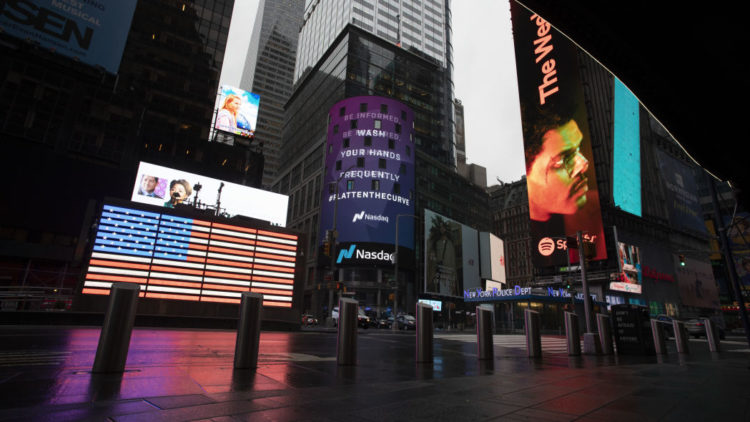American Lockdown: The Regime Tightens its Grip
The American Dream is dead. Any hopes or illusions about this country’s viability have been shattered by the repressive pandemic lockdown and the horrifying tyranny it’s unleashed. Below are portions of an excellent article published back on May 1st, less than a month before the George Floyd-inspired Antifa and Blacks Lives Matter terrorists began torching the streets. — Dissident Millennial

The Pandemic Road to Serfdom
Our Covid-era oligarchs are fitting us for feudalism
by George Kotkin | 05.01.2020
EVEN BEFORE the outbreak of the Covid-19 pandemic, America, like most higher-income countries, was already heading toward a neo-feudal future: massive inequality, ever-greater concentrations of power, and increasingly widespread embrace of a uniform (albeit secular) religion. The pandemic, all too reminiscent of the great plagues of the Middle Ages, seems destined to accelerate this process.
This can be seen by looking at something that many Americans, particularly conservatives, often long to ignore: class. In contrast to the post-World War II order, which engendered growing opportunity for the middle and working classes, the last few decades have seen the rapid concentration of wealth in virtually every major country in Europe and Asia.
The oligarchic class now owns as much as 50% of world’s assets. Just five companies — Alphabet, Amazon, Apple, Facebook, and Microsoft — account for over 20% of the market capitalization of the entire S&P 500 index.
Today’s new oligarchs constitute a modern-day equivalent of the Medieval aristocracy. Like the barbarians who seized control of land during the demise of Rome, they seem well-positioned to benefit from the emerging social distance-driven recession. The dislocation caused by the pandemic has greatly expanded the financial assets of the country’s increasingly hegemonic giant banks. But the biggest long-term winners are the big tech firms that dominate digital pathways at a time when the analog world, already failing, now faces inexorable obliteration.
Today’s other ascendant class is what I call the clerisy, who today fulfill the role played by the clergy in the Middle Ages. Known as the First Estate in pre-revolutionary France, the clerisy today is largely secular but consists of the key influencers in the media, academia, the upper bureaucracy and the ever-expanding “non-profit” sector. This new middle class enjoys something of a symbiosis with the oligarchic elites who mainly finance non-governmental organizations and the universities, and tends to a share a similarly progressive world view.
The people losing out most in the pandemic are the remnants of what was once dubbed the Third Estate: the commoners, long the bastion of democracy and liberal ideas. Millions of owners of small businesses have been devastated by the lockdowns, their lifetime investments allowed to turn to dust because the clerisy has declared them “non-essential” and hopes to keep them in lockdown well into the summer.
Worse still, as the promise of becoming business owners and homeowners has faded — particularly for the young — many increasingly fall into the insecure “precariat” of gig and part-time workers. These modern-day serfs are suffering the most from the pandemic. Millions of low-wage workers in hospitality, retail, and restaurants have lost their jobs and possess only meager prospects of getting them back in the near- or even medium-term future. Many others, largely low-wage service workers in “essential” jobs, are still working, but at high risk to themselves, often without adequate health and other protections.
How the Pandemic Drives Oligarchic Power
The new regime of social distancing, likely to remain influential for years to come, works most directly for the interests of the technologized oligarchy. The long-term decline of travel, convention, and traditional entertainment may mean disaster for millions of workers and many businesses, but it represents an enormous opportunity for those who can deliver food, goods, diversions, and experiences over the relative safety of digital networks.
But as jobs are destroyed on Main Street, others, like those at well-positioned Amazon, are created by the hundreds of thousands. It is also a rosy new dawn for online collaboration applications like Zoom, Google Hangouts, Facebook Rooms, Microsoft Teams, and Slack, the fastest-growing business app on record. Also greatly enhanced will be those who provide the infrastructure for the conquering digital economy, including chipmakers like Intel and cloud-computing behemoths like (yet again) Amazon and Microsoft.
The pandemic seems likely to further consolidate the tech industry shift from its garage-based startup past, with firms like Google, Facebook, Microsoft, and Amazon increasingly resembling Japan’s long-dominant keiretsu. The pandemic may have squashed many new companies that are now short on capital. In contrast, the oligarchic firms, which control upwards of 80% of such key markets as search, social media, cloud computing, and computer operating systems, now enjoy an even greater edge in garnering ever more of the nation’s technical talent. . .
The Coming Crisis of the Third Estate
In contrast, the pandemic has proven an utter disaster for much of the Third Estate. The most evident damage can be seen at the malls, or on Main Street, where millions of small firms have been forced to close and, at least in some locations, may be forced to stay locked down for many more months — even as some states and, in some parts of Europe, whole countries, are opening up.
In the aftermath of the lockdowns, small independent firms will be harder-pressed to compete against larger competitors with better access to capital and better positioning to wait out the pandemic. In the coming months, we might see many of our favorite local gyms and bars, or taco stands and family-owned Chinese restaurants, replaced by either online options or larger chains.
Well-financed large restaurant chains moved to the front of the line to secure their place atop the food chain, but the National Restaurant Association estimates that more than 8 million restaurant employees have been laid off or furloughed since the beginning of the coronavirus outbreak in March. This represents more than two-thirds of the 12 million employees that were working at the nation’s eating and drinking establishments in February.
Sadly these workers, and local business, can’t expect much help from Washington’s current stimulus plans. Even the Wall Street Journal admits the stimulus plan is “putting Wall Street ahead” of competing Main Street businesses. Republicans may talk a good game about smaller firms, arguably Trump’s strongest base, but at the end of the day they tend to take direction from large, globalized corporations and well-connected financial interests. Democrats, for their part, have little interest in smaller business as these tend to be owned by conservatives and are not amenable to unionization.
The generation of workers clipped by the Great Recession is now suffering the largest share of the job losses. Even those still working are stuck in the precariat, with little ability to control working conditions, terms of employment, or guarantees for health coverage. Such workers may try to use their leverage as “essential” to boost wages and improve conditions. We already see labor strife at Amazon, Instacart, Perdue, and McDonald’s. If nothing else, as Michael Lind suggests, the pandemic could “alter the balance of power among workers and employers.”
With the yeomanry thundering mostly from the Right, the protests of “essential” blue-collar workers could help boost the socialist cause. Roughly half of American households have no emergency savings and face an uncertain future as jobs disappear. A new class of ex-workers now finds the dole a more amenable or viable option than hard and dangerous work for relatively low pay. Bernie Sanders may have lost the nomination, but the message he ran on is amplified at a time when soup kitchens, as during the Depression, are now serving New York artists, writers, and musicians. The pandemic will likely increase the strong socialist tendency among both millennials and the successor Z generation.
More dangerous still may be the potential return to anarchy, particularly in the barrios and ghettos of the nation. In New York, the working-class transit-dependent communities of the outer boroughs can’t flee to second homes, work at home, walk to work, or take cabs like the Manhattan rich. As occurred in the wake of the great aerospace depression in Southern California in the early ’90s, diminished prospects can help light the flames of violent anarchy from the home on up. Family violence is already increasing in many countries.
Add to this toxic stew the fact that some jurisdictions, citing infection fears, have released dangerous criminals onto the streets. Crime has predictably spiked from New York to San Francisco. Even before the pandemic set in, the big American cities — unable to curb large homeless populations spreading filth and Medieval disease — took on the hazardous cast of ancient Rome, Victorian London, New York’s Five Points, or the favelas and ghettos of Third-World cities like Sao Paulo, Mexico City, or Manila. The rising number of people unable to pay rent — now one in three — could provide fodder for a new round of urban disorder.
Ultimately such disorder threatens the power of both the oligarchs and the clerisy. Their likely response may be embracing what I call “oligarchal socialism,” where the very notion of work disappears in favor of a regime of cash allotments. This notion of providing what Marx called “proletarian alms,” widely supported in Silicon Valley, could prove a lasting legacy of the pandemic. This is how Rome, as slaves replaced the middle orders, kept its citizenry in line, and how the Medieval order in times of economic stress relied on the charitable efforts of the Church.
The virus that now dominates our daily lives may soon begin to slowly fade, but it will have a deep, protracted impact on our society and class structure. Covid-19 will likely leave us with conditions that more resemble feudalism than anyone could have imagined just a few years ago.
* * *
Source: The American Mind






The Clermont Institute leans toward a neoconservative outlook and the author of this essay is a jew. Nevertheless, I have thought along the same lines as outlined in this essay to the degree that I am going to do some reading on the transition between Rome and the middle ages.
The really big difference between Conjob-1984 and plagues in the Middle Ages and ancient world is that people actually died from them.
The only reason I am believing that all of this
stuff is happening is because I am here to
witness it.
Germany – The MERKEL-Regime Tightens its Grip
Breaking news from Freiberg in Saxony: Kretschmer’s mercenaries have cordoned off the area of the Albert Park. They even take action against children.
Note to the American reader: Kretschmer is the Merkel-Governor of Saxony.